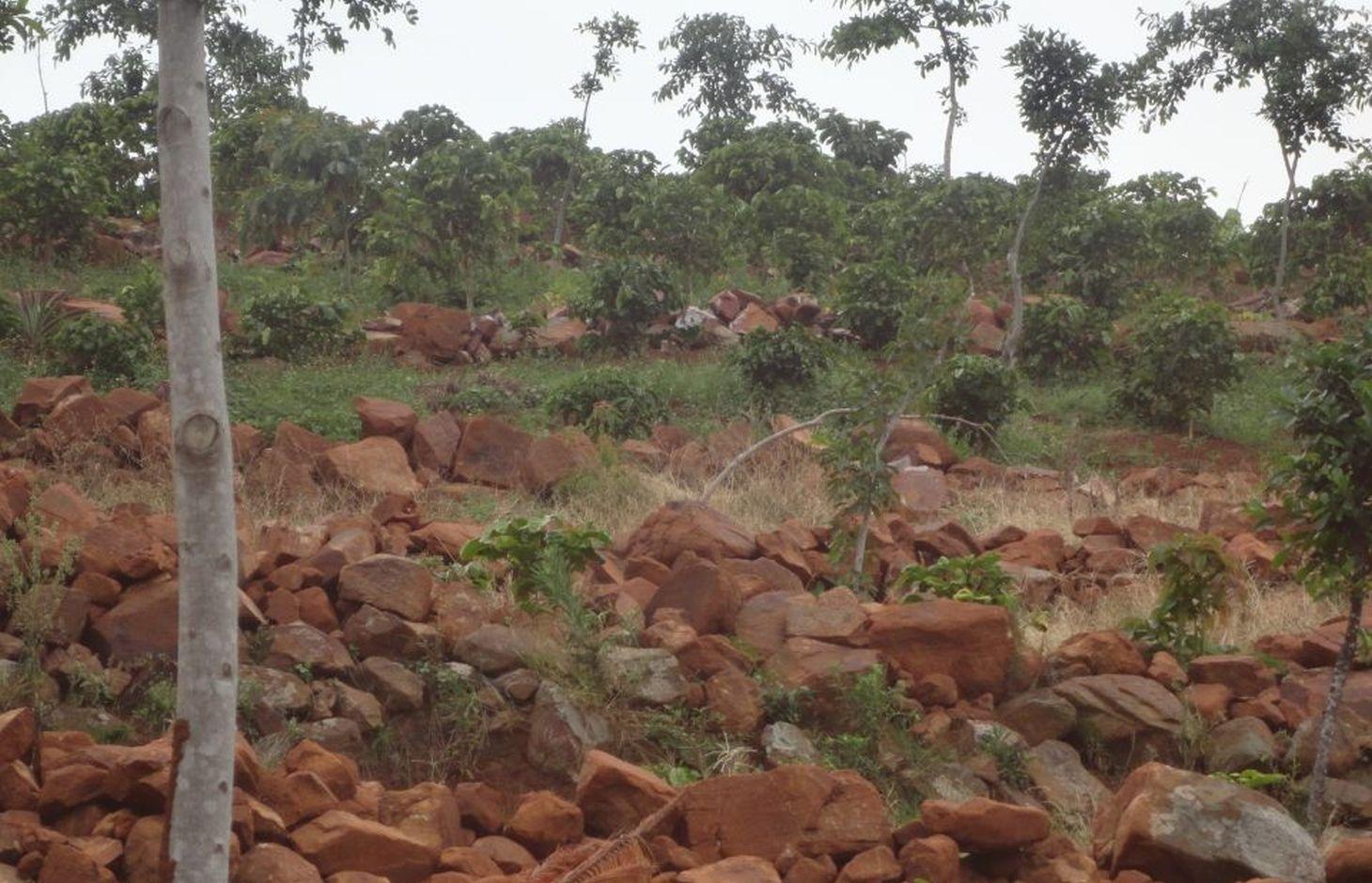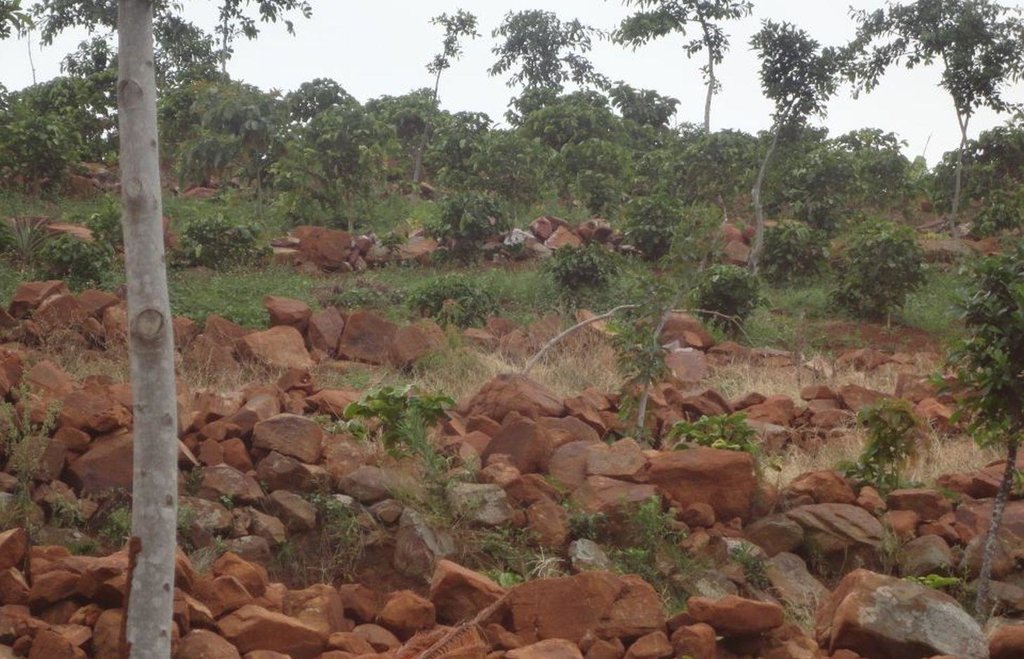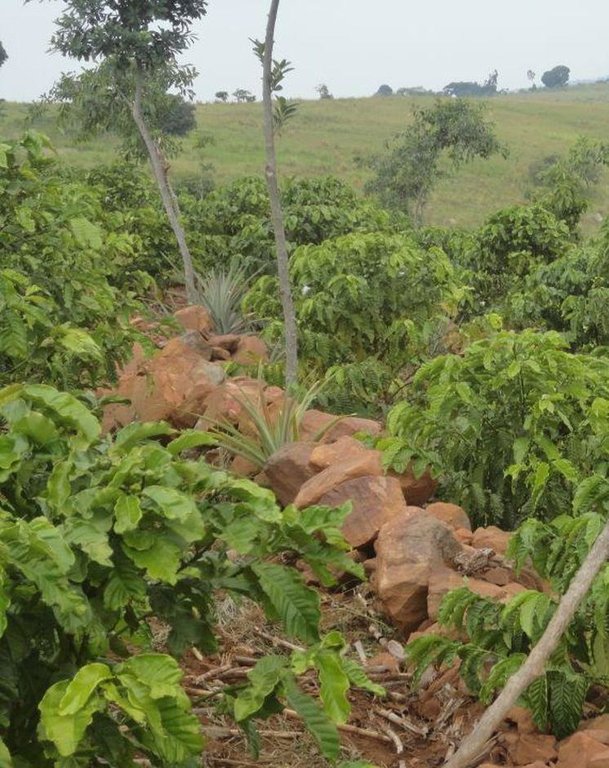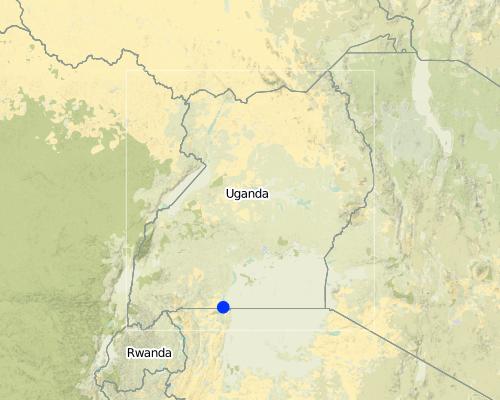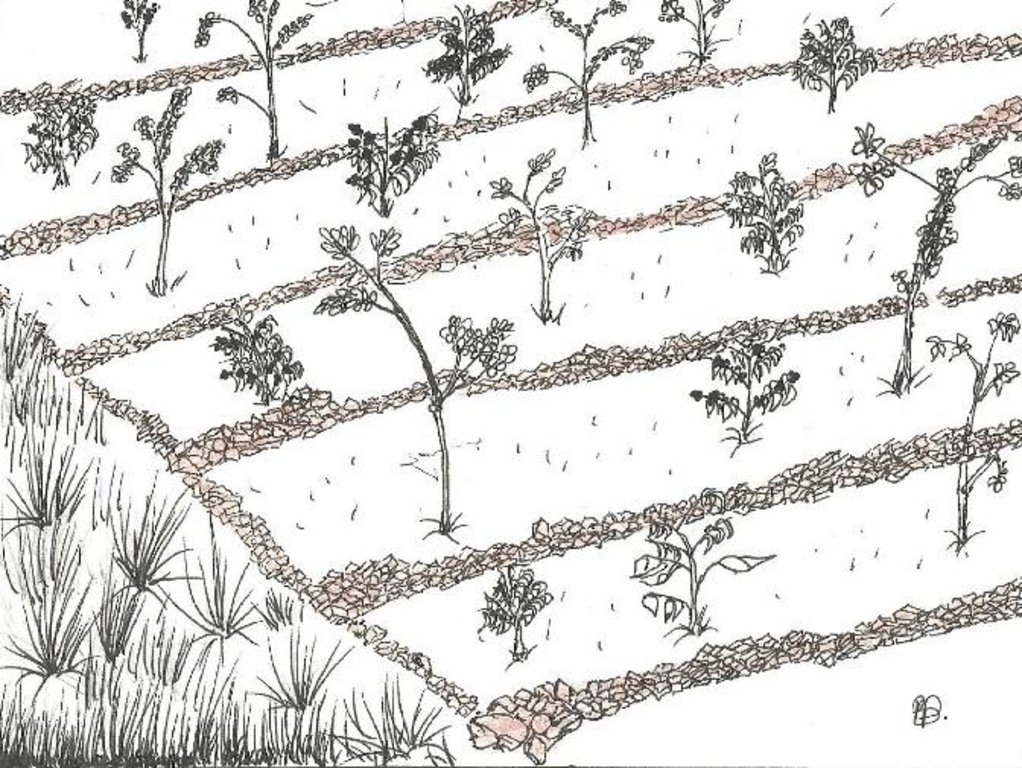Ficus Natalensis Agroforestry System [Ouganda]
- Création :
- Mise à jour :
- Compilateur : Wilson Bamwerinde
- Rédacteur : –
- Examinateur : Fabian Ottiger
Okusimba emituba n'ebimera
technologies_1153 - Ouganda
Voir les sections
Développer tout Réduire tout1. Informations générales
1.2 Coordonnées des personnes-ressources et des institutions impliquées dans l'évaluation et la documentation de la Technologie
Spécialiste GDT:
Spécialiste GDT:
Spécialiste GDT:
Lubega Emmanuel
Rakai district
Ouganda
Nom du projet qui a facilité la documentation/ l'évaluation de la Technologie (si pertinent)
The Transboundary Agro-ecosystem Management Project for the Kagera River Basin (GEF-FAO / Kagera TAMP )Nom du ou des institutions qui ont facilité la documentation/ l'évaluation de la Technologie (si pertinent)
Food and Agriculture Organization (FAO) - Italie1.3 Conditions relatives à l'utilisation par WOCAT des données documentées
Quand les données ont-elles été compilées (sur le terrain)?
05/12/2013
Le compilateur et la(les) personne(s) ressource(s) acceptent les conditions relatives à l'utilisation par WOCAT des données documentées:
Oui
1.5 Référence au(x) questionnaire(s) sur les Approches de GDT

Community development appraoch [Ouganda]
The approach involves the community and other development partners identifying opportunities, challenges and appropriate solutions through collective action.
- Compilateur : Wilson Bamwerinde
2. Description de la Technologie de GDT
2.1 Courte description de la Technologie
Définition de la Technologie:
Ficus natalensis based agroforestry system protects crops on windy hill slopes facing Lake Victoria and reduce runoff towards the meandering Kagera River Valley.
2.2 Description détaillée de la Technologie
Description:
Ficus natalensis is traditionally scattered in crop fields as a land management practice in central and south-western Uganda. The improved technology designed through community participation involves planting lines of Ficus natalensis along the contour at an interval that enables the tree to provide shade to young crops without depriving them of sunshine. When planted together with coffee trees or in banana plantations, the tall Ficus tree forms the top storey that protects the crop from the hot sun.
Purpose of the Technology: The main purpose of Ficus based agroforestry is to protect the soil from erosion. Within 3 to 5 years the Ficus tree forms a deep root system that stabilizes the soil. In addition, it drops leaves which quickly decay to provide both soil cover and manure thereby increasing the fertility of the soil. The trees provide firewood, fodder for livestock and bark cloth which can be used domestically or sold to supplement household income. They also act as wind breaks.
Establishment / maintenance activities and inputs: Ficus Natalensis is propagated using cuttings from young branches which are planted vertically 6 m apart along a contour. Propagation material is readily available and cheap, making the technology inexpensive to establish. Any annual or perennial crop can be inter-cropped with Ficus spp. provided the tree canopy is managed well. The tree is quite robust and can attain heights of over 20m, with a very extensive canopy if left to grow. Pruning raises its canopy to the desired height above the ground. In its early stages, fencing is required to protect the tree from damage by livestock. Within 12 to 18 months, however, the tree is established enough to withstand browsing. Only simple tools like hoes and garden forks for digging holes/pits are essential for establishment of the technology. The implementation of the technology on steep slopes (> 50%) is not possible without other supportive SLM interventions, in Rakai these include construction of stone lines and mulch application.
Natural / human environment: The pruned branches of Ficus natalensis are used as fuel wood when dry. Therefore scarcity of fuel wood may lead to over-harvesting of branches and destroying the canopy. Nonetheless, the tree regenerates quickly with the coming of the rains. Ficus tree can live for a hundred years.
2.3 Photos de la Technologie
2.5 Pays/ région/ lieux où la Technologie a été appliquée et qui sont couverts par cette évaluation
Pays:
Ouganda
Région/ Etat/ Province:
Uganda
Autres spécifications du lieu:
Rakai District (Kijonjo Parish)
Commentaires:
Boundary points of the Technology area: -0.96681 31.69066; -0.96706 31.69111; -0.96717 31.69033; -0.96757 31.69038; -0.96774 31.69073
Map
×2.6 Date de mise en œuvre de la Technologie
Si l'année précise est inconnue, indiquez la date approximative: :
- il y a moins de 10 ans (récemment)
2.7 Introduction de la Technologie
Spécifiez comment la Technologie a été introduite: :
- par le biais de projets/ d'interventions extérieures
Commentaires (type de projet, etc.) :
Agroforestry is a traditional practice but was reintroduced in a better structured, systematic form by organizations like VI-Agroforestry and Kagera TAMP.
3. Classification de la Technologie de GDT
3.1 Principal(aux) objectif(s) de la Technologie
- réduire, prévenir, restaurer les terres dégradées
- créer un impact économique positif
3.2 Type(s) actuel(s) d'utilisation des terres, là où la Technologie est appliquée

Terres cultivées
- Cultures annuelles
- Cultures pérennes (non ligneuses)
- Plantations d’arbres ou de buissons
Principales cultures (vivrières et commerciales):
Major cash crop tree and shrub cropping: Coffee
Major food crop perennial (non-woody) cropping: Banana
Major food crop annual cropping: Maize and beans

Mixte (cultures/ pâturages/ arbres), incluant l'agroforesterie
- Agroforesterie
Principaux produits/ services:
Major cash crop: Coffee
Major food crop: Bananas
Major other crop: Ficus Spp.
Commentaires:
Major land use problems (compiler’s opinion): Severe deforestation as trees were cut down for firewood, charcoal, timber and for agricultural use;
Overgrazing
Major land use problems (land users’ perception): Prolonged dry weather, destructive rainstorms and declining soil fertility
Type of cropping system and major crops comments: Agro-forestry is used in combination with banana and coffee growing.
3.3 Informations complémentaires sur l'utilisation des terres
Approvisionnement en eau des terres sur lesquelles est appliquée la Technologie:
- pluvial
Nombre de période de croissance par an: :
- 2
Précisez:
Longest growing period in days: 120 Longest growing period from month to month: February to May Second longest growing period in days: 120 Second longest growing period from month to month: September to December
3.4 Groupe de GDT auquel appartient la Technologie
- agroforesterie
3.5 Diffusion de la Technologie
Commentaires:
Total area covered by the SLM Technology is 0.06 m2.
The technology is becoming dominant in Kijonjo parish and other parts of Rakai district especially due to climatic changes that have led to shorter rainy seasons. However, farmers also recognize its potential for soil conservation.
3.6 Mesures de GDT constituant la Technologie

pratiques agronomiques
- A6: Autres

pratiques végétales
- V1: Couverture d’arbres et d’arbustes

structures physiques
- S11: Autres
Commentaires:
Main measures: vegetative measures
Specification of other agronomic measures: mulching (supp.
Specification of other structural measures: stone lines (supp.
Type of vegetative measures: aligned: -contour
3.7 Principaux types de dégradation des terres traités par la Technologie

érosion hydrique des sols
- Wt: perte de la couche superficielle des sols (couche arable)/ érosion de surface

dégradation biologique
- Bc: réduction de la couverture végétale
- Bq: baisse de la quantité/ biomasse
Commentaires:
Main type of degradation addressed: Wt: loss of topsoil / surface erosion, Bc: reduction of vegetation cover, Bq: quantity / biomass decline
Main causes of degradation: soil management (Lack of conservation measures), crop management (annual, perennial, tree/shrub) (Over cultivation), deforestation / removal of natural vegetation (incl. forest fires) (Cutting trees for timber and opening up more agricultural land), over-exploitation of vegetation for domestic use (Cutting trees for fuel wood and charcoal), poverty / wealth, education, access to knowledge and support services
Secondary causes of degradation: other natural causes (avalanches, volcanic eruptions, mud flows, highly susceptible natural resources, extreme topography, etc.) specify (Steep and very steep slopes)
3.8 Prévention, réduction de la dégradation ou réhabilitation des terres dégradées
Spécifiez l'objectif de la Technologie au regard de la dégradation des terres:
- réduire la dégradation des terres
4. Spécifications techniques, activités, intrants et coûts de mise en œuvre
4.1 Dessin technique de la Technologie
4.2 Spécification/ explications techniques du dessin technique
A diagram showing Ficus spp. trees planted to provide shade to coffee trees.
Location: Kijonjo B. village. Rakai
Date: 2013-12-05
Technical knowledge required for field staff / advisors: moderate (Knowledge of which trees will do well with the crops to be cultivated)
Technical knowledge required for land users: low (Land user dedication and a little guidance is enough for the implementation of the technology.)
Main technical functions: control of raindrop splash, control of dispersed runoff: impede / retard, improvement of ground cover, stabilisation of soil (eg by tree roots against land slides), reduction in wind speed, spatial arrangement and diversification of land use
Secondary technical functions: increase in organic matter, increase in nutrient availability (supply, recycling,…), increase of infiltration, increase / maintain water stored in soil, sediment retention / trapping, sediment harvesting, increase of biomass (quantity)
Aligned: -contour
Vegetative material: T : trees / shrubs
Number of plants per (ha): 250
Vertical interval between rows / strips / blocks (m): 20m
Spacing between rows / strips / blocks (m): 2m
Vertical interval within rows / strips / blocks (m): 2m
Width within rows / strips / blocks (m): 20m
Trees/ shrubs species: Ficus natalensis (also serves as perennial fodder), planted in the field using stem cuttings
Perennial crops species: Robusta coffee planted using seedlings bought from specialized nurseries
Slope (which determines the spacing indicated above): 35%
4.3 Informations générales sur le calcul des intrants et des coûts
autre/ monnaie nationale (précisez):
Ushs
Indiquer le taux de change du dollars en monnaie locale (si pertinent): 1 USD= :
2500,0
Indiquez le coût salarial moyen de la main d'œuvre par jour:
2.00
4.4 Activités de mise en place/ d'établissement
| Activité | Type de mesures | Calendrier | |
|---|---|---|---|
| 1. | Sourcing planting materials | Végétale | Beginning of rains |
| 2. | Making pits | Végétale | Beginning of rains |
| 3. | Planting cuttings | Végétale | Wet season |
| 4. | Spot weeding | Végétale | Wet season |
4.5 Coûts et intrants nécessaires à la mise en place
| Spécifiez les intrants | Unité | Quantité | Coûts par unité | Coût total par intrant | % du coût supporté par les exploitants des terres | |
|---|---|---|---|---|---|---|
| Main d'œuvre | Sourcing planting materials | ha | 1,0 | 30,0 | 30,0 | 100,0 |
| Main d'œuvre | Making pits | ha | 1,0 | 30,0 | 30,0 | 100,0 |
| Main d'œuvre | Planting cuttings | ha | 1,0 | 8,0 | 8,0 | |
| Main d'œuvre | Spot weeding | ha | 1,0 | 8,0 | 8,0 | |
| Equipements | 2 panga | ha | 1,0 | 8,0 | 8,0 | 100,0 |
| Equipements | 2 hoes | ha | 1,0 | 8,0 | 8,0 | 100,0 |
| Matériel végétal | Cuttings (500 stern cuttings) | ha | 1,0 | 30,0 | 30,0 | |
| Coût total de mise en place de la Technologie | 122,0 | |||||
Commentaires:
Duration of establishment phase: 2 month(s)
4.6 Activités d'entretien/ récurrentes
| Activité | Type de mesures | Calendrier/ fréquence | |
|---|---|---|---|
| 1. | Spot weeding | Végétale | twice a year |
| 2. | Pruning | Végétale | Wet season |
| 3. | Removing and processing the bark into bark cloth | Végétale | Once in 2 years |
4.7 Coûts et intrants nécessaires aux activités d'entretien/ récurrentes (par an)
| Spécifiez les intrants | Unité | Quantité | Coûts par unité | Coût total par intrant | % du coût supporté par les exploitants des terres | |
|---|---|---|---|---|---|---|
| Main d'œuvre | Spot weeding | ha | 1,0 | 8,0 | 8,0 | 100,0 |
| Main d'œuvre | Pruning | ha | 1,0 | 8,0 | 8,0 | |
| Main d'œuvre | Removing and processing the bark into bark cloth | ha | 1,0 | 14,0 | 14,0 | |
| Equipements | 1 panga | ha | 1,0 | 4,0 | 4,0 | 100,0 |
| Equipements | 1 hoe | ha | 1,0 | 4,0 | 4,0 | |
| Coût total d'entretien de la Technologie | 38,0 | |||||
Commentaires:
Machinery/ tools: The technology only requires simple tools like hoes and pangas.
The costs were calculated for wind breaks and optimum canopy after establishment. Calculations were done in December 2013, considering activities of the previous (September-November) wet season.
4.8 Facteurs les plus importants affectant les coûts
Décrivez les facteurs les plus importants affectant les coûts :
The most important factor affecting cost is labor to transport the bulky stem cuttings to the site. However, Ficus Natalensis is easy to establish and is durable (over 100 years) depending on management. It is extremely hardy and when it grows to 50cm to 100cm stem diameter it can be used for timber or to make dugout canoes. Establishment costs are easily recovered.
5. Environnement naturel et humain
5.1 Climat
Précipitations annuelles
- < 250 mm
- 251-500 mm
- 501-750 mm
- 751-1000 mm
- 1001-1500 mm
- 1501-2000 mm
- 2001-3000 mm
- 3001-4000 mm
- > 4000 mm
Spécifications/ commentaires sur les précipitations:
The area receives two rainy seasons (March-May & September-December)
Zone agro-climatique
- subhumide
Thermal climate class: tropics. The area lies at the equator.
The area has a dry and a wet season, but other factors influencing its weather include proximity to Lake Victoria and the Kagera River.
5.2 Topographie
Pentes moyennes:
- plat (0-2 %)
- faible (3-5%)
- modéré (6-10%)
- onduleux (11-15%)
- vallonné (16-30%)
- raide (31-60%)
- très raide (>60%)
Reliefs:
- plateaux/ plaines
- crêtes
- flancs/ pentes de montagne
- flancs/ pentes de colline
- piémonts/ glacis (bas de pente)
- fonds de vallée/bas-fonds
Zones altitudinales:
- 0-100 m
- 101-500 m
- 501-1000 m
- 1001-1500 m
- 1501-2000 m
- 2001-2500 m
- 2501-3000 m
- 3001-4000 m
- > 4000 m
Indiquez si la Technologie est spécifiquement appliquée dans des:
- situations convexes
Commentaires et précisions supplémentaires sur la topographie:
Altitudinal zone: 1001-1500 m a.s.l (1269-1310m a.s.l.)
Slopes on average: Steep (ranked 1, while technology is good for all kind of slope, the description given here is for a steep slope) and hilly (ranked 2)
5.3 Sols
Profondeur moyenne du sol:
- très superficiel (0-20 cm)
- superficiel (21-50 cm)
- modérément profond (51-80 cm)
- profond (81-120 cm)
- très profond (>120 cm)
Texture du sol (de la couche arable):
- grossier/ léger (sablonneux)
- moyen (limoneux)
Matière organique de la couche arable:
- moyen (1-3%)
Si disponible, joignez une description complète du sol ou précisez les informations disponibles, par ex., type de sol, pH/ acidité du sol, capacité d'échange cationique, azote, salinité, etc.
Soil depth on average: Shallow (ranked 1) and very shallow (ranked 2). The technology has also adopted to moderate to deep soils to support root development of trees.
Soil texture: Coarse/light (ranked 1, 70% of the soil in the area is sandy) and medium (ranked 2, 20% of the soil is loamy)
Soil fertility: Medium
Topsoil organic matter: Medium (the organic matter is medium but has improved with agroforestry)
Soil drainage/infiltration: Good (soils are manly sandy)
Soil water storage capacity: Low (soils are predominantly sandy)
5.4 Disponibilité et qualité de l'eau
Profondeur estimée de l’eau dans le sol:
5-50 m
Disponibilité de l’eau de surface:
faible/ absente
Qualité de l’eau (non traitée):
faiblement potable (traitement nécessaire)
Commentaires et précisions supplémentaires sur la qualité et la quantité d'eau:
Ground water table: 5-50 m (The technology does best in soils with ground table of 5-50m to enable root developement)
Availability of surface water: Poor/none (ranked 1, there is no surface water in dry season) and medium (ranked 2, some, in the wet season)
Water quality (untreated): Poor drinking water (treatement required, from unprotected source in swamps)
5.5 Biodiversité
Diversité des espèces:
- moyenne
Commentaires et précisions supplémentaires sur la biodiversité:
While the surrounding valleys below are swampy and very rich in biodiversity, only a fraction remains at the slopes due to destruction of habitats.
5.6 Caractéristiques des exploitants des terres appliquant la Technologie
Orientation du système de production:
- subsistance (auto-approvisionnement)
- mixte (de subsistance/ commercial)
Revenus hors exploitation:
- moins de 10% de tous les revenus
Niveau relatif de richesse:
- moyen
- riche
Individus ou groupes:
- individu/ ménage
Niveau de mécanisation:
- travail manuel
Genre:
- femmes
- hommes
Indiquez toute autre caractéristique pertinente des exploitants des terres:
Land users applying the Technology are mainly common / average land users
Difference in the involvement of women and men: n/a
Population density: 100-200 persons/km2
Annual population growth: 1% - 2%
21% of the land users are rich and own 57% of the land (Business men.).
63% of the land users are average wealthy and own 34% of the land (Teachers).
16% of the land users are poor and own 9% of the land (orphans and widows.).
Off-farm income specification: There is a difference in income levels between those who have implemented the technology and those who have not.
Level of mechanization: Manual work (only manual labour is used-casual labourers)
Market orientation: Subsistence (ranked 1, most produce is for home consumption only surplus is sold) and mixed (ranked 2)
5.7 Superficie moyenne des terres détenues ou louées par les exploitants appliquant la Technologie
- < 0,5 ha
- 0,5-1 ha
- 1-2 ha
- 2-5 ha
- 5-15 ha
- 15-50 ha
- 50-100 ha
- 100-500 ha
- 500-1 000 ha
- 1 000-10 000 ha
- > 10 000 ha
Cette superficie est-elle considérée comme de petite, moyenne ou grande dimension (en se référant au contexte local)?
- petite dimension
Commentaires:
Average area of land owned or leased by land users applying the Technology:
Ranked 1: 0.5-1 ha. For most average income families.
Ranked 2: <0.5-1ha. For the poor.
Ranekd 3: 1-2 ha. For the rich households.
5.8 Propriété foncière, droits d’utilisation des terres et de l'eau
Propriété foncière:
- individu, sans titre de propriété
- individu, avec titre de propriété
Droits d’utilisation des terres:
- individuel
Droits d’utilisation de l’eau:
- accès libre (non organisé)
Commentaires:
Most land users have access to untittled land and have open access to water.
5.9 Accès aux services et aux infrastructures
santé:
- pauvre
- modéré
- bonne
éducation:
- pauvre
- modéré
- bonne
assistance technique:
- pauvre
- modéré
- bonne
emploi (par ex. hors exploitation):
- pauvre
- modéré
- bonne
marchés:
- pauvre
- modéré
- bonne
énergie:
- pauvre
- modéré
- bonne
routes et transports:
- pauvre
- modéré
- bonne
eau potable et assainissement:
- pauvre
- modéré
- bonne
services financiers:
- pauvre
- modéré
- bonne
6. Impacts et conclusions
6.1 Impacts sur site que la Technologie a montrés
Impacts socio-économiques
Production
production agricole
Quantité avant la GDT:
100
Quantité après la GDT:
400
Commentaires/ spécifiez:
coffee and bananas
production de bois
Commentaires/ spécifiez:
For wood fuel (firewood & charcoal). there was almost nothing before.
risque d'échec de la production
Commentaires/ spécifiez:
conservation of moisture, improved soil fertility
diversité des produits
surface de production
Commentaires/ spécifiez:
Agricultural land on which Ficus is planted
Revenus et coûts
revenus agricoles
Commentaires/ spécifiez:
respondents reported increses in income but not documented.
diversité des sources de revenus
charge de travail
Commentaires/ spécifiez:
Realization of the benefits has led many farmers to need more help therefore raising the cost of labour
Impacts socioculturels
sécurité alimentaire/ autosuffisance
Commentaires/ spécifiez:
incresed agricultural produce.
opportunités culturelles
Commentaires/ spécifiez:
backcloth is used for cultural functions .eg. burying the dead.
apaisement des conflits
Improved livelihoods and human well-being
Commentaires/ spécifiez:
The technology has improved availability of both food and fuel wood. Some products from trees used in agroforestry such as backcloth (Embugo - Luganda) are sold, diversifying household income.
Impacts écologiques
Cycle de l'eau/ ruissellement
ruissellement de surface
évaporation
Sols
humidité du sol
couverture du sol
perte en sol
matière organique du sol/ au dessous du sol C
Commentaires/ spécifiez:
dried tree leaves add humus and organic matter in the soil.
Biodiversité: végétale, animale
biomasse/ au dessus du sol C
diversité végétale
Commentaires/ spécifiez:
various tree species are used for agroforestry.
espèces bénéfiques
diversité des habitats
contrôle des animaux nuisibles/ maladies
Réduction des risques de catastrophe et des risques climatiques
glissements de terrains/coulées de débris
Commentaires/ spécifiez:
Prevention of predisposition towards landslides
vitesse du vent
Commentaires/ spécifiez:
windbreaks reduced wind velocity.
Autres impacts écologiques
Risk of lightening strikes
6.2 Impacts hors site que la Technologie a montrés
inondations en aval
envasement en aval
pollution des rivières/ nappes phréatiques
dommages sur les champs voisins
6.3 Exposition et sensibilité de la Technologie aux changements progressifs et aux évènements extrêmes/catastrophes liés au climat (telles que perçues par les exploitants des terres)
Changements climatiques progressifs
Changements climatiques progressifs
| Saison | Type de changements/ extrêmes climatiques | Comment la Technologie fait-elle face à cela? | |
|---|---|---|---|
| températures annuelles | augmente | bien |
Extrêmes climatiques (catastrophes)
Catastrophes météorologiques
| Comment la Technologie fait-elle face à cela? | |
|---|---|
| pluie torrentielle locale | pas connu |
| tempête de vent locale | bien |
Catastrophes climatiques
| Comment la Technologie fait-elle face à cela? | |
|---|---|
| sécheresse | bien |
Catastrophes hydrologiques
| Comment la Technologie fait-elle face à cela? | |
|---|---|
| inondation générale (rivière) | pas connu |
Autres conséquences liées au climat
Autres conséquences liées au climat
| Comment la Technologie fait-elle face à cela? | |
|---|---|
| réduction de la période de croissance | bien |
6.4 Analyse coûts-bénéfices
Quels sont les bénéfices comparativement aux coûts de mise en place (du point de vue des exploitants des terres)?
Rentabilité à court terme:
positive
Rentabilité à long terme:
positive
Quels sont les bénéfices comparativement aux coûts d'entretien récurrents (du point de vue des exploitants des terres)?
Rentabilité à court terme:
très positive
Rentabilité à long terme:
très positive
Commentaires:
The costs for both establishment and maintenance are a small fraction of the benefits accruing from the technology.
6.5 Adoption de la Technologie
Si disponible, quantifiez (nombre de ménages et/ou superficie couverte):
8
Parmi tous ceux qui ont adopté la Technologie, combien d'entre eux l'ont fait spontanément, à savoir sans recevoir aucune incitation matérielle ou aucun paiement?
- 90-100%
Commentaires:
100% of land user families have adopted the Technology without any external material support
8 land user families have adopted the Technology without any external material support
Comments on spontaneous adoption: There is spontaneous adoption of the technology as it builds on traditional farming practices in the area.
There is a strong trend towards spontaneous adoption of the Technology
Comments on adoption trend: High demand for shade-grown coffee and bananas in addition to the highly valued bark cloth used in art and crafts has increased farmer appreciation.
6.7 Points forts/ avantages/ possibilités de la Technologie
| Points forts/ avantages/ possibilités du point de vue de l'exploitant des terres |
|---|
|
Ficus is used to provide backcloth that is sold for the making of Art and crafts and for cultural functions. How can they be sustained / enhanced? Management to accelerate healing of the bark within a shorter period should be investigated |
|
Trees shield crops from dangerous storms /rains and intense sunshine. How can they be sustained / enhanced? Encourage the spread of the canopy |
|
Ficus is good and attractive to birds and insects How can they be sustained / enhanced? Provision of material support in form of seedlings, farm tools for accelerated multiplication |
|
Ficus natalensis leaves are cut and fed to livestock like goats. How can they be sustained / enhanced? Encourage indeginous trees and growing fodder crops such as calliandra and nappier grass |
| Points forts/ avantages/ possibilités du point de vue du compilateur ou d'une autre personne ressource clé |
|---|
|
Demand for wood fuel is high How can they be sustained / enhanced? Local bye laws should be enacted to control deforestation and encourage tree growing |
|
It improves soil fertility-Ficus natalensis sheds leaves once every year, adding to soil humus. How can they be sustained / enhanced? More guidance should be given to the farmers for sustained spontaneous adoption of the technology |
|
It checks the speed of wind thereby protecting crops. How can they be sustained / enhanced? Other agricultural, ecological and social benefits could be explored in this scenic area facing the Kagera River where it enters Lake Victoria |
|
Stakes made from the Ficus branches can be used to grow climbing plants eg. passion fruits, yams as well as climbing beans How can they be sustained / enhanced? More tree planting should be encouraged |
|
Prevents soil erosion by checking raindrop splash, speed and amount of surface runoff and stabilizes the soil. How can they be sustained / enhanced? Because the ficus tree takes time to establish, other technologies such as trenches and grass strips could be used to reinforce it |
6.8 Faiblesses/ inconvénients/ risques de la Technologie et moyens de les surmonter
| Faiblesses/ inconvénients/ risques du point de vue de l’exploitant des terres | Comment peuvent-ils être surmontés? |
|---|---|
| The trees can hinder crops from light if canopy is dense | Prune periodically to enable other crops access to light |
| Some trees can fall especially during heavy and stormy rains, damaging plants and animals. | cutting excessive branches to reduce the load borne by trees. |
| Trees can attract lightening ,which destroys plants and animals. | Avoid putting animals under tall trees. |
| Faiblesses/ inconvénients/ risques du point de vue du compilateur ou d'une autre personne ressource clé | Comment peuvent-ils être surmontés? |
|---|---|
| Some tree species especially with short roots , compete with crops for nutrients. | Planting tree species with deep roots to avoid competition for nutrients. |
| It is a home for weaver birds and caterpillars. | Use scarecrows and biological control. |
7. Références et liens
7.2 Références des publications disponibles
Titre, auteur, année, ISBN:
Kagera TAMP project website
Disponible à partir d'où? Coût?
http://www.fao.org/nr/kagera/en/
Liens et modules
Développer tout Réduire toutLiens

Community development appraoch [Ouganda]
The approach involves the community and other development partners identifying opportunities, challenges and appropriate solutions through collective action.
- Compilateur : Wilson Bamwerinde
Modules
Aucun module trouvé


